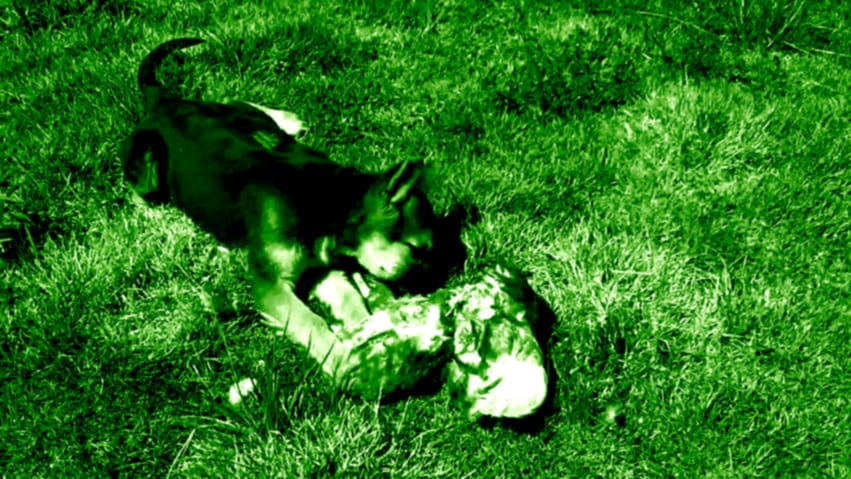
It is very normal for me to assume that everyone loves their dogs, since I love them. And it is an indescribable love. That love I feel for my dogs tends to create certain needs around them that motivate me to find ways to cover them in some way. And all this to have a relationship, as long and lasting as possible. So are dog loves. I would sign to spend my life with my dogs. And I know you do too. That is why you have to take good care of them, and that starts with trying to make them totally healthy. And we already know that begins with food. If we are what we eat, Is your dog healthy eating food from the Mercadona brand Compy, which costs 20 euros per 20 kilos?… What do we feed our animals? How does our way of approaching your diet affect your health? And if he is bad I think, What should my dog eat?
Today I am going to dedicate this article, to show you a new point of view for the nutrition of your dogsOne in which it is much more economical and healthy, and that will make the animal happier and happier, since it will be eating well and will have a balanced diet for what it is, a dog. Without further ado I leave you with the Canine Feeding Guide. I hope you enjoy reading.
What do we know about the subject?
The dog is a carnivore
I can't start talking about this without referring directly to my two previous posts on the subject of canine nutrition. On Dogs and food stress I tell you directly and without mincing words, how what you eat affects your dogs, and in History of the Pet Food Industry I tell you the whole truth and nothing but the truth about what we feed our animals. It is necessary that you read them before starting with this guide.
As we have already made clear, dogs are carnivores. No omnivores. If we think about it carefully, they have only been with us for a few thousand years, about 15000, and for me to vary the basic diet of an animal, it takes much more than 150.000 years. It's like saying that cows are going to become omnivorous and start eating meat just to be by our side. It's hard to believe, right? Well, surely it could be possible, however it would require a lot of time, time in quantities that are very difficult for us as humans to handle. Let's remember that our civilization is about 6000 years old.
Yes, our dogs are carnivores, and they need that meat to be able to have a proper life and feel good. Before feed-based diets, dogs had a diet based basically on human scraps, chicken shells, game scraps, etc. and their diet-related illnesses were practically zero.
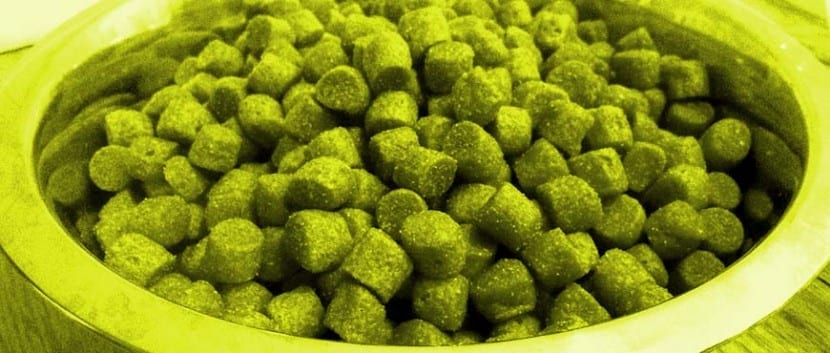
The dog food industry
Today, having a technology around the canine food industry, which should offer us a series of quality products, which makes us the task of feeding our animal better and more easily, with fewer health problems for them. It turns out that we have veterinary clinics FULL of dogs with food intolerance problems, diabetics, kidney dysfunction, heart problems, etc. And on top of that, having products that in theory are specific to help in a good recovery from the disease.
However, nothing could be further from the truth. As I already explained in a previous article (History of the Pet Food Industry), feeding our animals through feed, has turned the waste of large corporations and multinationals into real gold, having a profit of thousands of Billions a year. If I said well, thousands of Billions. This makes it one of the industries that most destines to advertising and to retain customers through it, at the same time that it is one of the sectors that takes care of the great multimacionals the most since it allows them to convert all the waste from sectors such as human food, fertilizers or soaps, by means of a simple processing (which is not expensive for them), into a product of 85 eu per 13 kilos bag . That they no longer put even 15 kilos. That's from Aesop's fable.
Veterinarians and brands
One of the ways they have to maintain all this great scam that the food in the form of fodder supposes for consumers that we give to our dogs the large multinationals such as Nestle Purina, Mars inc, Del Monte, Colgate-Palmolive or Kraft, it is through the education of veterinarians. Yes, my children ... how do you read it ...
We have to understand that a veterinarian is nothing other than a general practitioner of all animal breeds, which is to say, their preparation, not being specific towards some subject, is generally very basic in all areas. This means that their training in areas such as canine nutrition is very scarce and, for the most part, is based on studies and courses given by the companies themselves or by their workers. This is so.
One of the great problems of feeding our dogs is that canine feeding companies, They are the ones that finance and create all kinds of tests, scientific studies, conferences, congresses, books, etc. where they give scientific validity and social significance to their product through veterinary professionals who are then the ones who They sell us their higher-end feed, higher price and less quality within from their clinics, feed that damages the health of our animals from being their main source of food. I could say it louder, but not clearer. In the aforementioned article of History of the Pet Food Industry, I talk about it in depth.
And it is that this cannot continue like this. We cannot continue to condemn our dogs to eat a meal daily that is the closest thing to eating cookies that exists. There is a question that I ask my veterinarian every time he tells me that the healthiest thing for a dog is to eat pellets:
And why don't you eat feed without it being so healthy?
And they shut up and look at me with the face that I'm crazy, however I think my question is the most logical thing in the world. If it is such a complete food, and so healthy Why don't they eat it?… And the answer is easy… because of the nutrients. And because of the boredom of always eating the same thing.
Artificial food vs real food
All mammals, lions, tigers, giraffes, hyenas, elephants, dogs, humans, They look for the nutrients, enzymes, and bacteria necessary for their diet of wet foods, with large amounts of water. This is vital. It is not only feeding, it is also the quality of food.
When we compare the amount of water and dry matter that we find in 600 grams of feed and in 600 grams of natural food, we find that the feed is 90% dry matter and only 10% water, while in the natural food is 20% dry matter and the rest, 80% water. This means that in the same amount of food, the feed has 540 grams of dry matter against only 120 grams of the same in natural food. The difference is huge. A dry and highly processed product such as feed, subjected to high temperatures and pressure, loses many or almost all of its nutrients, essential in the dog's diet, which are then synthetically included, which is not even comparable to 120 gr of nutrients, of live enzymes and bacteria that come in natural food. As I already told you, the comparison is hateful.
However, I know that at this moment a question appears once more in your head:
But what do dogs have to eat then Antonio?
Very good question.
Dog feeding
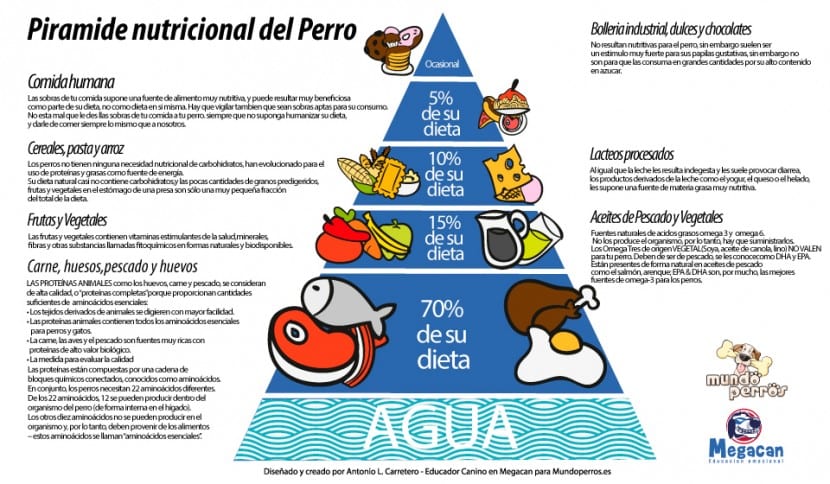
The piramid
With everything that I have been learning on the subject, I have created this canine food pyramid, where I give a quick summary of what you should base your dog's diet on, although now I am going to review it point by point.
Meat, bones, fish and eggs
It is the basis of the dog's diet. The dog needs quality animal protein, to be able to get from it the basic nutrients in the form of essential amino acids that lead him to obtain everything he needs. The 3 important factors to take into account to know the quality of the protein are: the source of the protein, the amino acid composition and its digestibility.
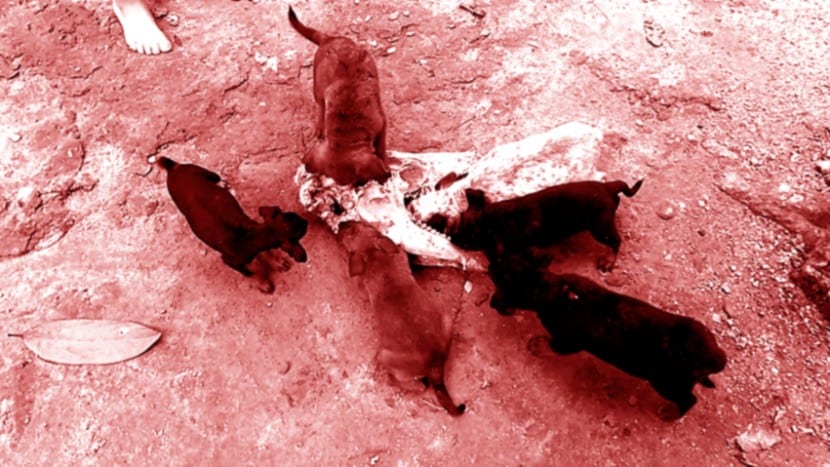
Protein source
Due to the different profiles of amino acids contained in animal and plant proteins, ANIMAL PROTEINS are considered “complete proteins” for dogs and cats, while PLANT PROTEINS are considered “incomplete proteins”.
Composition of amino acids
ANIMAL PROTEINS contain all essential amino acids for dogs and cats that conform to the
Necessary requirements for its general health, maintenance and growth.
PLANT PROTEINS like corn gluten, soybeans or isolated plant proteins do not contain all the amino acids in the correct proportions that a dog or cat needs.
Essential amino acids for dogs and cats that are often lacking in plant proteins include arginine, taurine, methionine, lysine and tryptophan, the latter essential for the production of serotonin, responsible for inducing the body to rest and helping to eliminate stress hormones.
Protein digestibility
Protein digestibility is a key quality measure.
After all, what benefit is there to have a food made with higher quality proteins if they cannot be easily digested?
A food with high protein digestibility is one that can be broken down into smaller, easily absorbed components more easily and quickly than others.
In the short digestive systems of dogs and cats, plant proteins are much less digestive than meat proteins, therefore animal proteins are the best option - they are easily digested and contain the essential amino acids for Dogs and cats.
Grease
Fat of animal origin is the greatest source of energy available to our dog. As this is incompatible with a healthy diet for a human, we draw the energy from the carbohydrates, it is hard for us to begin to believe that the dog does not get its energy from the same source that we do. Well, this is like this:
Fat as energy
According to the White Paper of Origin of the House Champions food:
• Both dogs and cats require a high amount of animal fat in their diets.
• As pets, cats and dogs enjoy a more sedentary lifestyle than their cousins wolves, and it is important to moderate the amount of fat, which should be between 15 and 18%.
• Although both fats and carbohydrates provide energy, they work very differently in the organism of a dog or cat. Fats are essential in cat and dog diets, carbohydrates are not.
• Carbohydrates provide energy faster than fat. In humans, a high intake of Carbohydrates increase muscle glycogen, which increases stamina. The same carbohydrate load in the dogs creates an excessive buildup of lactic acid in the muscles, producing a condition called hypoglycemia, which causes weakness and fatigue.
• Animal fats are clearly the best energy choice for dogs and cats.
Carlos Alberto Gutierrez tells us in his book, The Scandalous Truths of Dog Food:
Remember that although carbohydrates provide energy like fats, the latter have
essential functions that would not be achieved with carbohydrates.
Animal fat provides essential fatty acids that your dog cannot produce on its own. Example? Nothing more and nothing less than the important Omega 3 Fatty Acids.
You should moderate it but not suppress it, especially in dogs that are not very active or with little energy expenditure.
The bones
Bones are an important part of a dog's diet, however the food industry has instilled in us an appalling fear of including bones in our dog's diet.
However, the dog is a carnivore, on the same level as the wolf, the tiger or the black panther. There is a simple question that summarizes a bit the message I want to send you:
Can you imagine a panther removing the bone from a chicken before eating it?
I imagine the answer.
The bones according to the great nutritionist Carlos Alberto Gutierrez:
The dog in nature and for thousands of years was a hunter that fed mainly on the prey it caught, crushed the bones and thus obtained the calcium and phosphorus necessary for its bone structure, in addition to other minerals that we will see later.
There are few dogs that can resist nibbling the meat around the bone or fighting with the ligaments tightly attached to it. Let alone the delicious marrow that drives them crazy. It is true that we must take certain precautions and introduce them little by little - especially if they are adults and have never eaten them - until we make them a healthy habit. Before getting into this healthy habit, let's see some interesting facts and details that will help us understand the importance of its inclusion in the diet.
On average, beef or pork bones contain 23 to 32% calcium, 13 to 15% phosphorus, 6 to 8% protein, and 7 to 10% moisture. But not only that, it is also a source of sodium (5,5%), iron (2,6%), magnesium (0,3%), zinc (0,1%) and some amino acids such as lysine and methionine. Believe it or not, bones are a source of fatty acids present in the bone marrow (marrow) and with more polyunsaturated fatty acids and phospholipids than intramuscular and subcutaneous fat.
If it is true, that the cooked bone loses so much water that it becomes very dry and it will possibly be a problem for our animal to say it normally and remove the nutrients, since it will have lost them during cooking. Therefore, DO NOT GIVE COOKED BONES to the dog. That is a sure problem.
It is necessary to differentiate between alimentary bone (chicken, rabbit, partridge, quail) high in fat, and recreational bone (from cow, pork, veal, etc), which is something very stimulating for him, however we cannot let him gobble it up or make him feel bad. The recreational bone also serves to clean their teeth as well as being a great entertainment for them. As I said before, the stimulus they get through food is very important. I will analyze this topic a little later with a little more depth.
Beef, pork, chicken, turkey, lamb, rabbit or horse, fish and eggs are the main source of animal protein that our dog needs.
The meat can be supplied raw or lightly cooked. Or fry it. It is always clear that it does not have a bone. If they are meaty bones, raw please. Fish is preferable cooked or canned, and monitor very well if you have Anisakis, which can be a problem for the dog. I personally prefer to give it canned, which also takes advantage of vegetable oil, which gives it something. Eggs, cooked, fried or in an omelette, however you want, raw they can be indigestible.
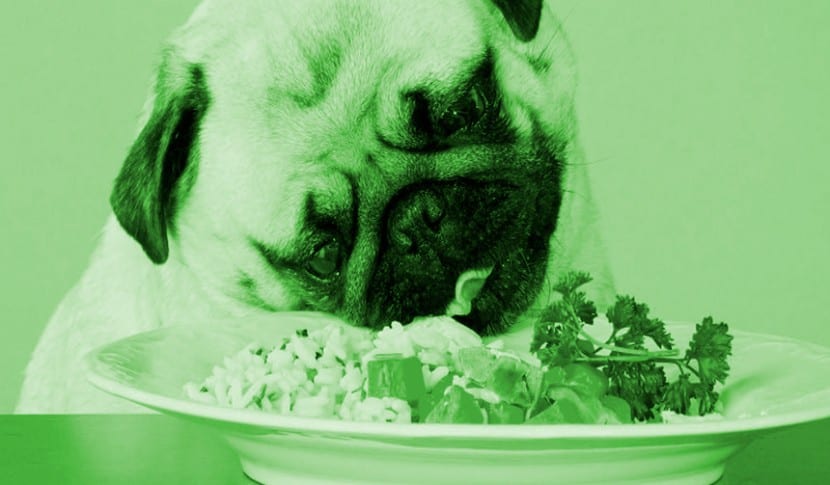
Fruit and vegetable
Fruit and vegetables are a small but important part of our dog's diet, since they have nutrients in the form of minerals, fibers and substances called phytochemicals, and all this from a natural source.
In nature, a dog would only eat the fruit, grains, seeds, vegetables and tubers that its prey carries in its intestines, which is a very small amount.
The dog, as we have said before, is a carnivorous animal and does not process the carbohydrates present in fruits and vegetables.
While we can feed the fruit raw, the vegetables should be cooked or fried a little, which will help make it more digestible.
Fish and vegetable oils
Fish oils are a source of essential omega 3 and omega 6 fatty acids, essential in the diet of our dog, since he cannot synthesize them. According to the Orijen White Paper:
Essential fatty acids are the fatty acids present in the fats required by the body.
Because they cannot be produced within the body, essential fatty acids must come from food.
The most important are linoleic and arachidonic4 (Omega-6), and DHA and EPA (Omega-3).
A proper balance between omega 6 and omega 3 is important as these two fats work together. A ratio of 2: 1 to 5: 1 is generally accepted as ideal for cats and dogs.
Since omega-6 deficiencies are extremely rare, many pet foods have too much omega-6 and too little omega-3.• The quality of omega-3s varies greatly between plant and animal sources.
• Of the 3 types of omega-3: ALA (alpha-linolenic acid) comes from plants, while DHA (dicosahexaenoic acid) and EPA (epicosapentaenoic acid) come from fish.
• Dogs and cats require DHA and EPA, not ALA.The omega-3 from plants is ALA, a short-chain omega-3 found in soybeans, rapeseed oil, and flax.
ALA must be converted to EPA and DHA to be nutritionally beneficial for a dog or cat.
As cats and dogs are not adapted to carry out this conversion, the omega-3 ALA from plants is considered "inactive" and not biologically suitable for dogs and cats.
EPA and DHA | Omega-3 from fish
Animal omega-3s (EPA and DHA) are long-chain omega-3s that are absorbed directly into the body. Naturally present in fatty fish like salmon, herring, and corigone, EPA and DHA are by far the best omega-3 choice for dogs and cats.
We can find fish oils, such as salmon or herring, in various formats, from a liter, to capsules, however we should consult with our nutritionist veterinarian, which should be the appropriate form and quantity.
Cereals, pasta, rice
As we have said before, we must maintain the contribution of carbohydrates from cereals to a minimum, since although they are very beneficial for humans, in the dog they are not as nutritious, as Orijen's White Paper explains:
Carbohydrates are divided into two main groups:
1). SIMPLE CARBOHYDRATES or sugars
two). COMPLEX CARBOHYDRATES.
SIMPLE CARBOHYDRATES
Simple carbohydrates are made up of simple sugars, or two sugars put together, and are found in grains like corn, wheat, and rice.
• Simple sugars are quickly absorbed into the bloodstream, causing a rapid rise in blood sugar levels.
• This rapid rise causes the body to spike insulin levels and the result is that sugars are turned into fat.
• Rapid rise in blood sugar levels is usually followed by a rapid drop, causing feelings of hunger and weakness.COMPLEX CARBOHYDRATES
Complex carbohydrates have more than two sugar units together and are found in potatoes, legumes, as well
than in many other vegetables and fruits.
• Complex carbohydrates can take a long time to break down in the stomach or pass undigested, creating
bulky stools
Dogs and cats have no nutritional need for carbohydrates and have evolved to use
proteins and fats as sources of energy.
• The natural diet contains almost no carbohydrates, and the small predigested cereals, fruits and vegetables of the stomach of
a prey make up a very small fraction of the total diet.
• Today's high carbohydrate pet foods cause blood sugar fluctuations, insulin resistance and are considered to be a cause of obesity, diabetes and the initiation of other health problems in dogs and cats.
• Conventional dry pet foods have a very high carbohydrate content, with many foods exceeding 40-50% of the total carbohydrate content.
• Almost half of dry dog foods are non-essential simple sugars! This important fact is often not known by consumers as manufacturers are not required to indicate the carbohydrate content of their packaging.
• Carbohydrate intake in excess of the dog's daily needs (which is often the case with conventional pet foods) causes internal enzymes to store the extra carbohydrates as body fat.
• The Nutrient Profiles of the American Association of Food Control Officials (AAFCO) show that carbohydrates are not essential for dogs and cats and that a minimum level of carbohydrates is not necessary in their diets.
• According to Dr. David S. Kronfeld, it is not necessary to supply carbohydrates to adult dogs, not even those who work hard, as the liver is able to synthesize enough glucose (from protein and fat).
Therefore, feeding the dog with high levels of rice or cereal and taking it out for a run causes a very opposite effect to what we want to achieve, since the dog gets energy from fat and not from carbohydrates, which will end up creating a sensation. of tiredness and fatigue.
The proportions when mixing some cereals with our dog's food is 1 part of cereal, for every 3 of animal protein and one of fruit or vegetables.
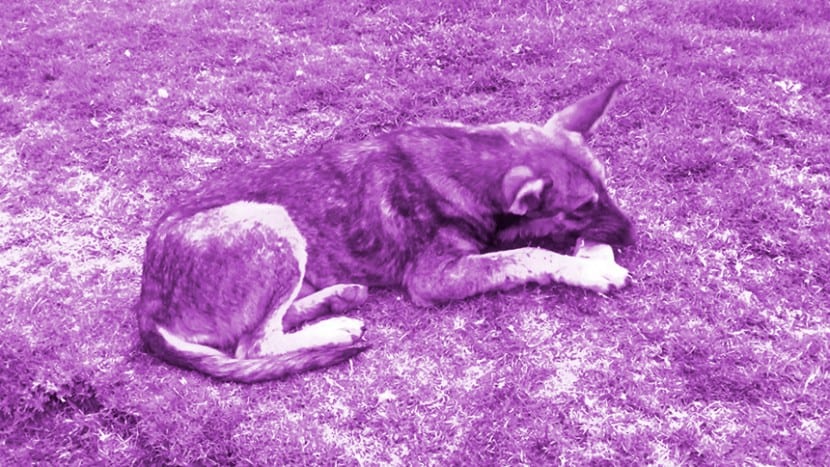
Dairy Processes
Like cow's milk, it usually causes diarrhea, since it is not able to digest it well (after all, no animal drinks milk after adulthood, only man) products derived from milk such as cheese, yogurt or ice cream, rich in fat, are digestive and healthy for them. Here you have to apply a little personal criteria, a matter that I will deal with more extensively later.
Human food
Who has not ever given their dog some of the food that we make for ourselves?
In the past, those who controlled the dog food market were the butchers. However, it was very normal for the family dog to eat pout just like the family. This has its positives and its negatives.
Among the positives is that the dog will have a varied source of nutrients and that will be cheaper. Among the negatives are cooked bones that cause all kinds of problems or humanize the dog's diet too much.
Industrial pastries, sweets, chocolates
Although they do not have much nutritional value, neither for dogs nor for us, if it is a suitable reward, since an ounce of chocolate is a flavor bomb for your taste buds. It is not a treat for every day, however it can be a sweetheart for some days.
Two important concepts: variety and criterion
First of all, when facing this paradigm shift when it comes to feeding our dog, we must handle two ideas that seem important to me to achieve a good nutritional balance for our animal:
- Variety: The dog is a mammal and is very similar to the human in many things, including the need for a varied diet in all kinds of nutrients, or for example getting positive stimuli through your food, getting to have this certain playful aspect, as well as it also has its side of learning experience and its socializing side. There are many health and behavioral problems of our dogs that are related to feed, either on a physical level, through all kinds of diseases, as well as on a mental and intellectual level. Submitting to a diet as strict as giving our dog the same feed every day for years, deprives him of one of the most important stimuli of his life as a dog, food, which is for them their main fun along with play. . For all this, and because you would not keep eating ham and prawns all your life, and even less if they give it to you in the form of a biscuit, making our dog have a varied diet, it is something very important at all levels.
- Criterion: There are many dog feeding guides on the web. I'm not going to deny it. Some are by great professionals, however, for the most part, they are articles that journalists who have nothing to do with the dog world, take out of feeding guides that are created by Nestle Purina or Kraft to sell their feed lines. Nothing to do with reality. This guide is not so. This guide is made with the help of professional nutritionists and looking for the truth in your dog's diet. In actually feeding him. And in order to do this, I have given you a lot of data for you to use at your discretion. The diet of our dog is highly conditioned by the new popular culture around its diet, whose main source of arguments are studies, conferences, and all kinds of empirical tests by billionaire paid professionals by brands to show what they want: That feed is good for the dog and natural food is not. For it have generated a whole series of myths around the feeding of dogs, ignoring any trace of responsibility or professionalism in them, condemning millions of animals to eat a diet that is not healthy for them, and all for an economic reason. This leaves us with a clear violation of the trust that must exist on the part of a customer towards the manufacturer of the product he buys, which sells you a complete food for your dog that is not at all a complete food for your dog if not quite the opposite, a source of health problems. Although most of these myths have a small scientific basis, most of it is pure and simple demagoguery, demonizing foods such as potatoes or onions, creating a series of myths about their consumption in dogs. All these myths and legends I will analyze in depth in my next article, however there is one thing clear, everything is bad in excess. If you feed him onion every day for a month, you will surely kill him. Eat your only onion for a month. This is where I speak of having a little personal judgment. It is not bad for your dog to eat your macaroni with tomato and onion, or to eat the rest of your cake or your ice cream. Giving him ice cream every day will be a problem. Criterion please.
Point and end
Having our dog well fed can often be a matter of some practice and desire, and with this we will achieve real wonders. My brother Javier Carretero, had his dog Gus, a West Higland Terrrier a whopping 25 years. It is not a joke. And he had vitality until he was 23. And he did not eat a pellet of feed in his life.
Without further ado I leave you until my next article, a recipe book for your dogs created by me, where I will give you recipes that take us from the introduction phase to natural food, to its maintenance.
Thank you from here to Carlos Alberto Gutierrez from Dog Nutritionist.com, for her teachings and patience, and Silvia Beseran from GEDVA for putting me on the path of meeting my dog from another point of view.
Take care of your dogs. They are the best you have.
Natural food also helps control your weight
Hello Maria. Thanks for comment. Totally true. All the best.
Hello good morning, what do you think of dehydrated dog food like naku or summun?
Thank you very much.
Hello Miriam. Thanks for comment. Both Naku and Summun are 2 good brands of dog food, however as I always say, it is not to just give them just that type of food either. I once again insist on two concepts that I like a lot, variety and criteria. All the best.
Hi itsukikatsuraLaura, thanks for commenting. In the guide, there is a taxonomy (the food pyramid) where you can see how the foods that best and worst come to your dog are listed. This taxonomy or pyramid, is already in itself, a guide on what is best for you and what feels worst for you. Then, already in the texts, I make specific indications and develop it a bit. If you read the article, you will be able to see that apart, that I speak of two concepts that I believe are main to be able to start feeding your dog in a logical way: Variety and Criterion. There are no 100% bad or 100% beneficial foods for the dog, as with humans, it is rather a question of quantities.
On the other hand, it gives me the feeling of not having explained myself totally well, or that is the feeling that remains, when reading your comment about what the dog should NOT eat. For my part, I urge you to read it again and consult me here with any specific questions you may have.
According to brands, I recommend NAKU in dehydrated foods and any feed from the Champion Foods factory. A greeting.
Hello, if you could help me with a diet for my dog, she has allergies, she is a Sharpei cross with a Labrador, the vet just told me that he did not give her something prepared that I did especially for her but that I only give her seeds but she is already 1 year old. 1 month and I think it's already 7 months with skin allergies, her hair falls out x parts, please help me, greetings from Chloé's part? and me his mom Canina Dennys
Thank you very much for this page, and for the feeding guide. I live in Colombia, I have an adopted dog that apparently was born from a cross between the bearded collie and another breed. Your articles seem very well supported by expert sources and with a lot of reasoning. Generally all industries hire scientists, doctors or experts to endorse their methods and products, which is usually not very ethical, if the expert is being financially rewarded by those same industries to endorse instead of looking for the convenient truth most of the species that are subject to this consumption.
On behalf of my dog, I thank you for the information, which at least makes many of us think, and take real measures that improve the quality of life of pets.
Thank you for the valuable information, and do not be afraid to tell the truth, it is inconceivable that our pets are harmed with the «» supposed food »» that has all the nutrients,… »« Pure wheat flour «and more trans "The same thing that is making people sick and killing and nobody says anything not to lose their" "slice" in such a lucrative business. I hope one day they will pay for the crime they commit left and right in the complicity of the authorities
Hello, a taste ... excellent article very true ... I have always given my dog a balance between homemade food and croquettes as intercalated ... after reading this I will correct some other mistakes that I have been committing such as not giving him bones ... I will try ... maybe adapting it to his diet little by little ... on the other hand my puppy lately has been developing very severe skin irritations ... maybe food poisoning ... I'm worried about !!! ... maybe there is an effective diet for his condition ???? P.S. (Breed: Siberian Huskie) very grateful !!!
Thank you very much for the article, it is very well documented and based on studies and proven facts. Congratulations. It has helped me a lot to orient myself and know that I can feed my dog.